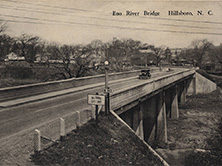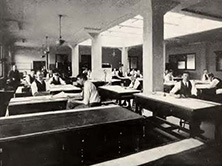 Eno River Bridge (Orange County Bridge 52) in Hillsborough, built by State Highway Commission in 1922 following state standards for reinforced concrete tee beam structures (Durwood Barbour Collection of North Carolina Postcards, UNC-Chapel Hill)
Eno River Bridge (Orange County Bridge 52) in Hillsborough, built by State Highway Commission in 1922 following state standards for reinforced concrete tee beam structures (Durwood Barbour Collection of North Carolina Postcards, UNC-Chapel Hill) When North Carolina embarked on its statewide road and bridge improvement programs in the late 1910s, the great period of innovation and experimentation in bridge designing was coming to an end.
Rolled-steel beams and reinforced concrete had emerged as the prevailing bridge building materials based on their availability, economy, ease of erection, capacity, and maintenance requirements. The rolled steel stringer and reinforced concrete arch, T-beam and slab types so dominated the national scene after World War I that bridges from North Carolina to Maine to California were virtually indistinguishable.
 Bridge department drafting room (Fourth Biennial Report of the State Highway Commission, 1921-1922) North Carolina's historic highway bridges tend to reflect the national trends in bridge building technology that were marked more by the increased strength and standardization of materials than development of innovative designs. The state's bridges illustrate the nearly universal application of standardized types to any combination of crossing requirements.
Bridge department drafting room (Fourth Biennial Report of the State Highway Commission, 1921-1922) North Carolina's historic highway bridges tend to reflect the national trends in bridge building technology that were marked more by the increased strength and standardization of materials than development of innovative designs. The state's bridges illustrate the nearly universal application of standardized types to any combination of crossing requirements.
Standardized steel stringer and reinforced concrete, T-beam construction accounted for more than 70 percent of North Carolina's pre-1961 highway bridges. The rest are a handful of other types, including metal truss; reinforced concrete arch, slab, rigid frame, and through girder; steel girder-and-floorbeam; creosoted timber stringer; and movable bridges.
A new material, pre-stressed concrete, appeared in the mid-1950s and was quickly recognized for its strength and versatility.